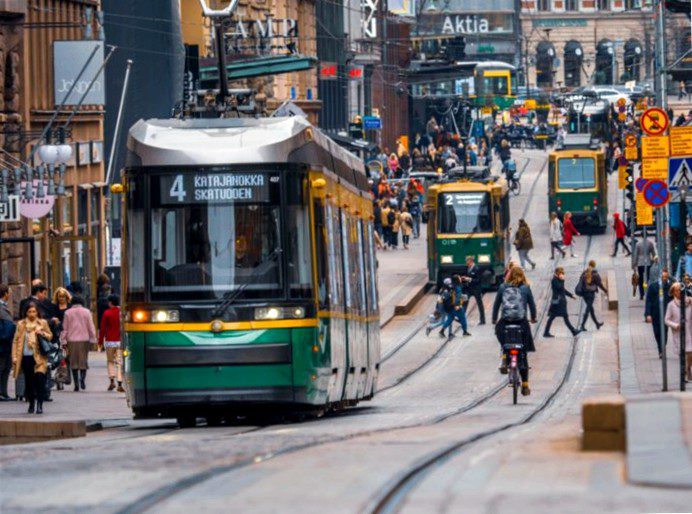Finland ends homelessness and provides housing for all those in need

Finland has seen a sharp drop in the number of homeless people. The reason for this: the state applies the "Housing First" concept. Those affected by homelessness receive a small apartment and advice – without any preconditions. 4 out of 5 affected people find their way back to a stable life this way. And it's cheaper than accepting homelessness to boot.
Finland is the only country in Europe where homelessness is declining
In 2008 you could see tent villages and huts standing between trees in the parks of Helsinki. Homeless people had built temporary houses in the middle of Finland's capital city. You were exposed to harsh weather conditions.
Since the 1980s, Finnish governments have tried to curb homelessness. Short-term shelters have been built. However, long-term homeless people continued to be left out of the loop. There were too few emergency shelters, and many of those affected were unable to escape homelessness: they could not find work without a home address. And without work they could not find an apartment. It was a vicious circle. They also had problems applying for social security benefits. All in all, the homeless found themselves trapped
In 2008, however, the Finnish government introduced a new policy for the homeless: it began implementing the "Housing First" concept. Since then, the number of people affected has fallen sharply.
And the country is successful! It is the only EU country where the number of homeless people is decreasing.
How everyone gets a residence in Finland
It is NGOs like the "Y Foundation" that provide housing for people in need. They take care of the construction themselves, buying apartments on the private housing market and renovating existing apartments. The apartments have one or two rooms. In addition, former emergency shelters were converted into apartments to provide long-term housing.
"It was clear to everyone that the old system wasn't working; we needed radical change," said Juha Kaakinen, director of the Y Foundation.
Homeless people become tenants with a rental contract. You also have to pay rent and operating costs. Social workers, who have offices in the residential buildings, help with financial issues such as applying for social benefits.
Juha Kaakinen is head of the Y Foundation. The NGO receives subsidized loans from the government to buy housing. In addition, social workers who take care of the homeless and future tenants are paid by the state. The Finnish Lottery, on the other hand, helps NGOs buy homes on the private housing market. The Y Foundation also regularly receives loans from banks. The NGO later uses the rental income to repay the loans.
"We had to get rid of the night shelters and short-term housing that we still had at that time. They had a very long history in Finland, and everyone could see that they were not getting people out of homelessness. We decided to reverse the assumptions," said Juha Kaakinen, director of the Y Foundation.
Here's how the "Housing First" concept works.
The policy applied in Finland is called "Housing First". It reverses the traditional homelessness assistance. More often, they are expected to find a job and get rid of their mental problems or addictions. Only then do they receive help in finding housing.
"Housing First," on the other hand, reverses course: Homeless people get an apartment – without any preconditions. Social workers will help you apply for social benefits and are available for general advice. In such a new, secure situation, people find it easier to find a job and take care of their physical and mental health.
The results are impressive: 4 out of 5 homeless people are able to keep their homes for a long time with "Housing First" and lead a more stable life.
Over the past 10 years, the Housing First program in Finland has put 4.600 apartments made available. In 2017, there were still about 1.900 people on the streets – but there were enough places for them in emergency shelters so that at least they no longer had to sleep outside.
Providing housing is cheaper than leaving them on the street
Creating living space for people costs money. In the last 10 years, 270 million euros have been spent on the construction, purchase and renovation of housing under the Housing First program. However, according to Juha Kaakinen, this is far less than the cost of homelessness itself. Because when people are in emergency situations, emergencies occur more frequently: Assaults, injuries, collapses. Police, health and justice systems are called upon to intervene more often – and that costs money, too. By comparison, Housing First is cheaper than facing homelessness: The state now gives 15 per year per homeless person.000 euros less than before.
No miracle cure – but a high success rate
Since 4 out of 5 people keep their apartment, "Housing First" is effective in the long term. In 20 percent of cases, people move out because they prefer to live with friends or relatives – or because they can't manage to pay the rent. But even in this case, they will not be dropped. You can reapply for housing and get assistance again if you want it.
Of course there is no guarantee of success. Homeless women in particular are harder to reach. They hide their emergency situation more often and they are less likely to live on the streets and prefer to stay with friends or acquaintances.
The translation from English was done by Janel Stieber of the Pressenza volunteer translation team. We are looking for volunteers!